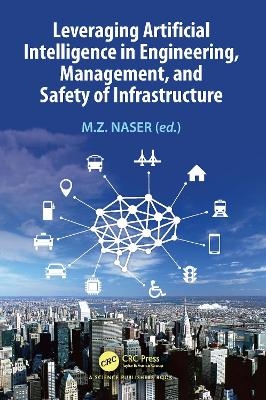
Leveraging Artificial Intelligence in Engineering, Management, and Safety of Infrastructure
CRC Press (Verlag)
978-1-032-30575-2 (ISBN)
The design, construction, and upkeep of infrastructure is comprised of a multitude of dimensions spanning a highly complex paradigm of interconnected opportunities and challenges. While traditional methods fall short of adequately accounting for such complexity, artificial intelligence (AI) presents novel and out-of-the-box solutions that effectively tackle the growing demands of our infrastructure. The convergence between AI and civil engineering is an emerging frontier with tremendous potential.
The book is likely to provide a boost to the state of infrastructure engineering by fostering a new look at civil engineering that capitalizes on AI as its main driver. It highlights the ongoing push to adopt and leverage AI to realize contemporary, intelligent, safe, and resilient infrastructure. The book comprises interdisciplinary and novel works from across the globe. It presents findings from innovative efforts supplemented with physical tests, numerical simulations, and case studies – all of which can be used as benchmarks to carry out future experiments and/or facilitate the development of future AI models in structural engineering, traffic engineering, construction engineering, and construction materials.
The book will serve as a guide for a wide range of audiences, including senior undergraduate and graduate students, professionals, and government officials of civil, traffic, and computer engineering backgrounds, as well as for those engaged in urban planning and human sciences.
M.Z. Naser is a tenure-track faculty member at the School of Civil and Environmental Engineering & Earth Sciences, a member of the AI Research Institute for Science and Engineering (AIRISE) at Clemson University, USA. Dr. Naser has co-authored over 100 publications and has 10 years of experience in structural engineering and AI. His research interest spans causal & explainable AI methodologies to discover new knowledge hidden within the domains of structural & fire engineering and materials science to realize functional, sustainable, and resilient infrastructure. He is a registered professional engineer and a member of various international editorial boards and building committees.
1. Convolutional Neural Networks and Applications on Civil Infrastructure 2. Identifying Non-linearity in Construction Workers' Personality: Safety Behaviour Predictive Relationship Using Neural Network and Linear Regression Modelling 3. Machine Learning Framework for Predicting Failure Mode and Flexural Capacity of FRP-Reinforced Beams 4. A Novel Formulation for Estimating Compressive Strength of High Performance Concrete Using Gene Expression Programming 5. Implementation of Data-Driven Approaches for Condition Assessment of Structures and Analyzing Complex Data 6. Automatic Detection of Surface Thermal Cracks in Structural Concrete with Numerical Correlation Analysis 7. State-of-the-Art Research in the Area of Artificial Intelligence with Specific Consideration to Civil Infrastructure, Construction Engineering and Management, and Safety 8. Artificial Intelligence in Concrete Materials: A Scientometric View 9. Active Learning Kriging-Based Reliability for Assessing the Safety of Structures: Theory and Application 10. A Bayesian Estimation Technique for Multilevel Damage Classification in DBHM 11. Machine learning and IoT Data for Concrete Performance Testing and Analysis 12. Knowledge-enhanced Deep Learning for Efficient Response Estimation of Nonlinear Structures 13. Damage Detection in Reinforced Concrete Girders by Finite Element and Artificial Intelligence Synergy 14. Deep Learning in Transportation Cyber-Physical Systems 15. Artificial Intelligence in the Construction Industry: Theory and Emerging Applications for the Future of Work 16. The Use of Machine Learning in Heat Transfer Analysis for Structural Fire Engineering Applications 17. Using Artificial Intelligence to Derive Temperature Dependent Mechanical Properties of Ultra-High Performance Concrete 18. Smart Tunnel Fire Safety Management by Sensor Network and Artificial Intelligence
| Erscheinungsdatum | 17.08.2022 |
|---|---|
| Zusatzinfo | 63 Tables, black and white; 2 Line drawings, color; 150 Line drawings, black and white; 6 Halftones, color; 36 Halftones, black and white; 8 Illustrations, color; 186 Illustrations, black and white |
| Verlagsort | London |
| Sprache | englisch |
| Maße | 156 x 234 mm |
| Gewicht | 843 g |
| Themenwelt | Informatik ► Theorie / Studium ► Künstliche Intelligenz / Robotik |
| ISBN-10 | 1-032-30575-4 / 1032305754 |
| ISBN-13 | 978-1-032-30575-2 / 9781032305752 |
| Zustand | Neuware |
| Informationen gemäß Produktsicherheitsverordnung (GPSR) | |
| Haben Sie eine Frage zum Produkt? |
aus dem Bereich


